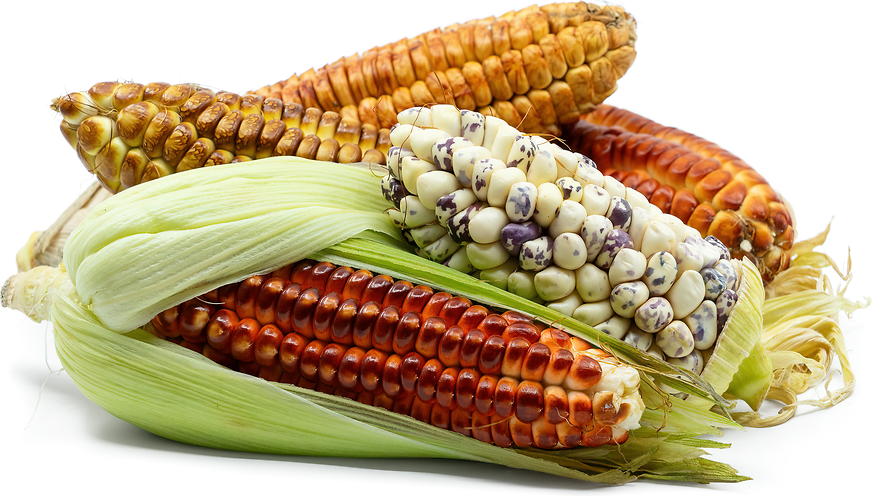


Colored Peruvian Corn
Estimated Inventory, lb : 0
Description/Taste
Colored Peruvian corn is small to medium in size and is cylindrical to elongated in shape, slightly tapering to a point at one end. On the surface, there are many small seeds, also known as kernels, that are found tightly wrapped around the ear of the corn in many different patterns depending on the specific variety. These kernels range in shape from oblong to pointed with a slightly beaked tip and vary in color from light yellow, gold, red, to variegated colors and striations. Underneath the kernels, the ear of the corn is typically white and has a firm, pithy, and spongy texture. Colored Peruvian corn is crunchy and starchy with a mild, neutral, and subtly sweet flavor.
Seasons/Availability
Colored Peruvian corn is available in the spring through summer.
Current Facts
Colored Peruvian corn, botanically classified as Zea mays, is a general descriptor used to encompass many different varieties of corn that belong to the Poaceae family. Ranging in color from red, gold, yellow, white, purple, to mixed hues, corn has been cultivated in Peru for thousands of years and is one of the most important sustainable crops along with potatoes, especially in the Cuzco valley which was once the capital of the Inca empire. There are more than fifty-five varieties of corn grown in Peru, cultivated and sold in local markets, and Colored Peruvian corn is favored for its unusual hues, shapes, and textures, and can be incorporated into culinary applications or used ornamentally.
Nutritional Value
Colored Peruvian corn contains some vitamin C, vitamin B, iron, magnesium, fiber, and potassium.
Applications
Colored Peruvian corn is best suited for cooked applications such as boiling and roasting. The kernels can be ground and incorporated into stews, chowders, and soups, ground and mixed with cumin, stock, and oil to make tamales, blended into corn pie, or ground to make flour. Depending on the colored variety, some Peruvian corn can also be toasted to make cancha, which is a popular crunchy corn snack served by street vendors and in local bars as a salty accompaniment to drinks. Colored Peruvian corn pairs well with lime, cumin, garlic, onions, chile pepper, beans, cheese, quinoa, potatoes, peanuts, and meats such as beef, pork, chicken, and seafood. The kernels will keep 1-3 days when fresh but can also be dried for extended use.
Ethnic/Cultural Info
In Peru, the Festival of Choclo is an annual festival that celebrates corn and the economic impact the crop has had on the country since the times of the Incas. Held in March in the district of Huayllabamba, which is in the province of Urubamba within the Cuzco valley, the festival features hundreds of local farms and growers, each showcasing different corn varieties. Festival attendees can also try local delicacies sold from food vendors while watching live dance and musical performances. Traditional dishes that are commonly sold at the festival include maicillos, or corn cookies, cancha which are toasted kernels, and a corn cake known as pastel de choclo. Lawa de maiz, a corn chowder, is also popularly sold at the public event along with various versions of tamales.
Geography/History
Corn is believed to be native to Mesoamerica and has been cultivated since ancient times, but the exact origins are largely unknown. Believed to have been spread by migrating peoples, corn was introduced into North and South America where it became one of the most cultivated and important crops for the survival of indigenous tribes. Today Colored Peruvian corn is made up of many different varieties that can be found at fresh markets, mainly localized to Peru and select regions in South America.
Recipe Ideas
Recipes that include Colored Peruvian Corn. One
| What's 4 Eats |
|
Cancha |
| Cupcakes & Kale Chips |
|
Peruvian Style Grilled Street Corn |
| Que Rica Vida |
|
Garlic Rice with Corn |




